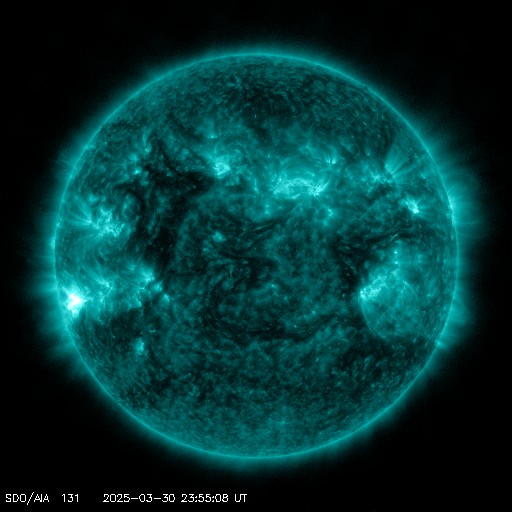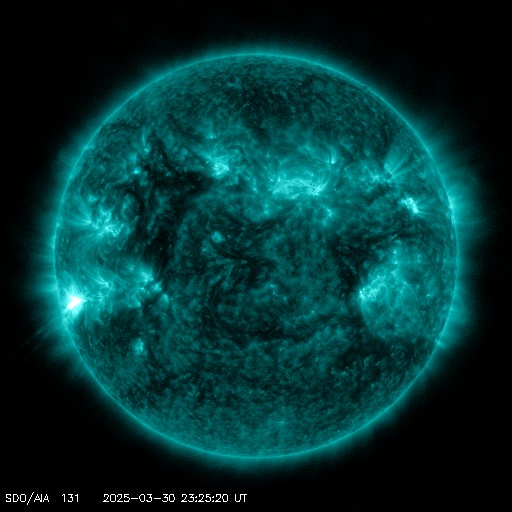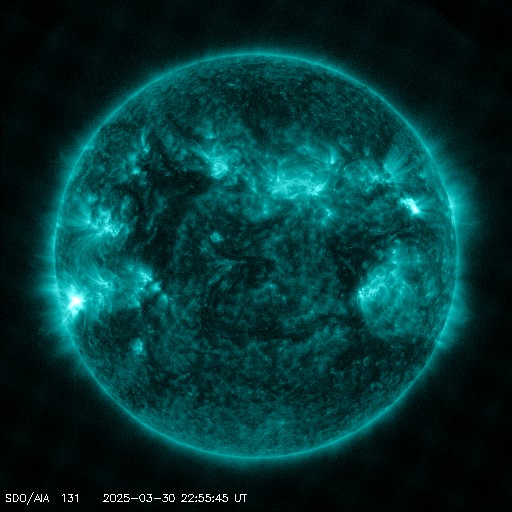Het archief bekijken van vrijdag 10 november 2000
Activiteitenrapport
Bij elke genoemde zonnevlam in dit rapport werd een schaalfactor toegepast door het Space Weather Prediction Center (SWPC). Vanwege de SWPC-schaalfactor worden zonnevlammen 42% kleiner gerapporteerd dan voor de wetenschappelijke data. De schaalfactor werd verwijderd uit onze gearchiveerde zonnevlamdata om de werkelijke fysieke eenheden weer te geven.
Rapport van de zonne- en geofysische activiteit van 2000 Nov 10 2200 UTCOpgemaakt door de NOAA © SWPC en verwerkt door Poollicht.be
USAF/NOAA rapport van de zonneactiviteit en geofysische activiteit
SDF Nummer 315 gepubliceerd omstreeks 2200Z op 10 Nov 2000IA. Analyse van de actieve zonneregio's en zonneactiviteit van 09-2100Z tot 10-2100Z
Solar activity was low. Today's largest event was a
C6/1f from Region 9225 (S20W48) at 09/2122Z. There appears to be
some gradual flux emergence in this region. The rest of today's
activity consisted of a few low-level C-class events. Two new
regions were assigned today, Region 9229 (N04E70) and Region 9230
(N05W39). Both are simple and stable. There has been a noticeable
decline in activity and in background levels as regions 9218, 9212,
and 9213 rotate around the west limb.
IB. Voorspelling zonneactiviteit
Solar activity is expected to be low
to moderate. Regions 9218 (N21W83) and 9227 (S13E24) appear to be
the most likely sources for activity at this time.
IIA. Samenvatting geofysische activiteit 09-2100Z tot 10-2100Z
The geomagnetic field has been at unsettled to major storm levels.
The field was initially running at unsettled to active levels, but a
strong interplanetary shock passed the ACE spacecraft at 0604Z and
was followed promptly by a sudden impulse at 0629Z (measuring 67 nT
in Boulder), and a period of minor to major storm level activity
(i.e. K-indices of 5 and 6). The solar wind following the shock did
not exhibit strongly southward fields, and the result was a weaker
disturbance than had been expected, with a decline to active to
unsettled during the last nine hours of the period. This shock most
likely is the result of the CME associated with the M7 flare of 8
November, and the solar wind signatures are consistent with an
interpretation that the Earth received a glancing, rather than a
direct blow from the interplanetary disturbance. Event level proton
fluxes continued today at the greater than 10 MeV and 100 MeV
levels. Flux levels declined throughout the period, with current
levels (as of 10/2100Z) of 192 pfu and 1.3 pfu at 10 MeV and 100 MeV
respectively.
IIB. Voorspelling geofysische activiteit
The geomagnetic field is
expected to be mostly active during the next 24 hours, but there may
be with periods of minor to major storm levels, particularly during
local nighttime hours. Active levels are expected to continue
through the second day and partway through the third day, as effects
are expected from a favorably positioned coronal hole. The greater
than 100 MeV proton event should end within a few hours, but the
greater than 10 MeV event is likely to continue into the third day.
III. Kans zonnevlammen van 11 Nov tot 13 Nov
| Klasse M | 35% | 35% | 35% |
| Klasse X | 05% | 05% | 05% |
| Proton | 99% | 99% | 70% |
| PCAF | in progress | ||
IV. Penticton 10.7 cm Flux
Geobserveerd 10 Nov 153 Voorspeld 11 Nov-13 Nov 150/150/150 90 dagen gemiddelde 10 Nov 173
V. Geomagnetische A index
Geobserveerd Afr/Ap 09 Nov 010/011 Geraamd Afr/Ap 10 Nov 030/040 Voorspeld Afr/Ap 11 Nov-13 Nov 025/035-020/020-015/020
VI. Kansen op geomagnetische activiteit van 11 Nov tot 13 Nov
| A. Gemiddelde breedtegraad | |||
|---|---|---|---|
| Actief | 40% | 40% | 30% |
| Kleine storm | 30% | 30% | 20% |
| Zware-ernstige stormcondities | 10% | 10% | 10% |
| B. Hoge breedtegraad | |||
|---|---|---|---|
| Actief | 15% | 15% | 25% |
| Kleine storm | 50% | 50% | 40% |
| Zware-ernstige stormcondities | 20% | 20% | 15% |
Alle tijden in UTC
<< Keer terug naar de dagelijkse overview pagina
Op basis van de huidige parameters is er nu geen kans op poollicht in België en Nederland
Op basis van de huidige parameters is er in de nabije toekomst een beperkte kans op poollicht op de volgende locaties van de hoge breedtegraad
Gillam, MB, Yellowknife, NTLaatste nieuws
Laatste forumberichten
Suggesties? 8Noorderlicht kans 6-1-2025 2Poollicht 1 januari 2025 2Naar Noorwegen in Maart? 3Noorderlicht kans 10/11-10-2024 56
Meer forumberichtenSteun Poollicht.be!
Om ook bereikbaar te blijven bij grote poollichtkansen hebben we een zware server nodig die alle bezoekers aankan. Doneer en steun dit project zodat we online blijven en je geen enkele poollichtkans mist!

Laatste alerts
00:09 UTC - Zonnevlam
Matige M1.03 zonnevlam
zondag 30 maart 2025
23:51 UTC - Radio blackout
Kleine R1 radio blackout gedetecteerd (≥M1 - momenteel: M1.03)
23:39 UTC - Zonnevlam
Matige M1.52 zonnevlam
23:21 UTC - Radio blackout
Kleine R1 radio blackout gedetecteerd (≥M1 - momenteel: M1.49)
23:09 UTC - Zonnevlam
Matige M1.48 zonnevlam
Ruimteweer feitjes
| Laatste X-klasse uitbarsting | 28/03/2025 | X1.1 |
| Laatste M-klasse uitbarsting | 30/03/2025 | M1.0 |
| Laatste geomagnetische storm | 27/03/2025 | Kp5 (G1) |
| Zonnevlekkenloze dagen | |
|---|---|
| Laatste zonnevlekkenloze dag | 08/06/2022 |
| Maandelijks gemiddeld zonnevlekkengetal | |
|---|---|
| februari 2025 | 154.6 +17.6 |
| maart 2025 | 127 -27.6 |
| Afgelopen 30 dagen | 127 -25.7 |





